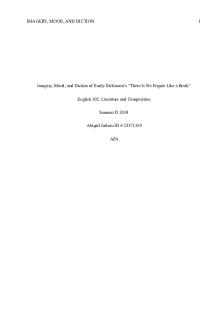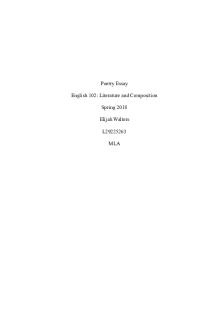Poetry Essay -The Immigrant’s Song by Tishani Doshi PDF

| Title | Poetry Essay -The Immigrant’s Song by Tishani Doshi |
|---|---|
| Author | Ashlee Abrahams-Fitzgerald |
| Course | Global Literature and Film |
| Institution | University of the Witwatersrand, Johannesburg |
| Pages | 5 |
| File Size | 118.4 KB |
| File Type | |
| Total Downloads | 62 |
| Total Views | 179 |
Summary
The poem The Immigrant’s Song by Tishani Doshi portrays an immigrant’s reflection of the world and the life they have left behind by moving to a new country. The poem expresses the immigrant’s attempt to adapt and compartmentalise the past in order to integrate themselves into their new circumstance...
Description
ENGLISH 100 ESSAY COVER SHEET NAME
: Ashlee Cayte Abrahams-Fitzgerald
STUDENT NO: 1611269 GROUP NO:
5
TUTOR: Leyya Hoosen DIAGONAL
:A
DUE DATE
: 24 March 2017
WORD COUNT: 1235 words
PLAGIARISM DECLARATION I declare that this essay is my own independent work. Where I have consulted secondary sources, I have acknowledged them appropriately. In particular (please check the boxes)
I have referenced arguments that I have summarized or paraphrased from other sources. I have referenced (documented) all ideas or expressions (words, phrases, etc) derived from other sources. I have provided the relevant bibliographical details of all primary and secondary materials used in preparing this essay. If I have been working in collaboration with others on this essay, I have ensured that the final version of my essay is original (I have not copied anything from anyone else’s essay).
I UNDERSTAND WHAT CONSTITUTES PLAGIARISM AND I DECLARE THAT, TO THE BEST OF MY KNOWLEDGE, I HAVE NOT COMMITTED ANY PLAGIARISM.
SIGNATURE:
DATE:
Ashlee Cayte Abrahams-Fitzgerald Student Number: 1611269
Assignment 4: The Immigrant’s Song
The poem The Immigrant’s Song by Tishani Doshi portrays an immigrant’s reflection of the world and the life they have left behind by moving to a new country. The poem expresses the immigrant’s attempt to adapt and compartmentalise the past in order to integrate themselves into their new circumstances. “The wind”, mentioned at the end of the poem, references how past and present are linked in such a way that the stories of the immigrant’s past will innately be communicated through generations.
The first section of the poem, namely the first fifteen lines, describes an immigrant’s poignant sense of nostalgia for their homeland. Although the images of “coffee beans” (line 2) and “mothers’ headscarves” (line 3) evoke a positive response - as these items are intimate and natural - there is a threatening undertone in the immigrant’s fond recollection of “white flags” (line 4), as this image may symbolise surrender to an overpowering force, especially when the poem later mentions “men, stolen” (lines 11 and 12) from their homes. The mention of the “disappeared” in line 14, indented and italicised, also expresses an unsettling aspect of the immigrant’s homeland and the dangers there, presumably as a result of political repression. The repetition of “Let us not speak” in lines 1,5 and 11 therefore project the disturbing and unsafe past that the immigrant may have endured, possibly indicating the reason for the character’s emigration.
There is a shift in line 16 as the word “instead” indicates a change in tone and setting. The speaker now attempts a positive focus on their “lives now” (line 16) - the present - and how it is different from their past life. In this section of the poem, the poet expresses the immigrant’s wish to abandon their past in favour of the opportunities that stand before them under their new circumstances. These opportunities are presented in the forms of “the gates and bridges and stores” (line 17), whilst the imagery of the breaking of bread in line 18 symbolises a ritualistic assimilation into the new society. However even the context of the present evokes painful memories for the character, as they recall “stories of war or abandonment” (lines 21 and 22) and
how these stories would be a “burden” (line 21) on those they have encountered in their new lives.
The poem shifts again in line 27 as the immigrant begins to consider their “future”. It is in this section of the poem that the concept of “the wind” (line 44) gains context as the immigrant considers a future in which “grandchildren” (line 28) will speak in “forked tongues” (line 29) about their ancestors’ homeland. It is at this point of the poem that ‘memory and forgetting’ is solidified as a major theme. This becomes clear as the immigrant attempts to forget their past by apparently remaining silent in the previous sections – although, of course, the poem itself is breaking that silence whereas now they consider how this memory will impact on further generations into the future. This also demonstrates how the past and present are intertwined in a way that affects the future.
From line 35 until the end of the poem, Doshi uses simile to produce the image of “a paper boat down a river” (line 36) and compares it to setting “memory afloat” (line 35), or remembering. The notion of a “paper boat” (line 36) expresses an entire aspect of the immigrant’s mindset, as this object would be fragile and uncontrollable, referring to the immigrant’s vacillating and discombobulating memories. However it seems that, as the memory is set afloat, the writing on paper interacts with the water, which passes on the words to the trees and the leaves. The wind, blowing through the trees gathers up the immigrant’s stories and ensures they will reach the world and be communicated to those who have not experienced such a life transition for themselves, as well as those who live in a future beyond which the immigrant can imagine.
In this way the title, The Immigrant’s Song, must be considered. The idea of a ‘song’ is significant as often songs are traditionally passed down through generations and contain information about a community’s culture and history. In the same way, the immigrant’s story is carried, song-like, from line 37 to line 41 through the paper’s whisper, the singing water, and the tree’s howling to the leaves. The diction “whisper”, “sings” and “howl” all act as elements of sound which increase in volume in order to combine with “the wind” (line 44) which can “howl” (line 40) through not
only the leaves, but through the world. It is therefore through the wind, that the immigrant’s story can “fill the world” (line 43) and become “the only word” (line 44).
This change to speaking from silence between the first and final line acts as an ongoing tension throughout the poem. The difference between the first line “let us not speak” and line 42 “do not speak” is that between these two lines the immigrant has overcome their fear of mentioning the past and so the act of silence transforms as the act is not out of apprehension (as is expressed in line 1) but instead out of respect for the song, which can be heard in the silence. In the poem the immigrant must make a choice between voice and voicelessness, and it seems that by the poem’s end the choice is to utilise the voice in order to create a song that can last for eons through “the wind”. As the wind is an unconquerable and uncontrollable voice, by allowing the wind some control over the story, the story itself becomes unconquerable.
In contrast to this argument, the final line “until the wind is the only word” (line 44), could symbolise that inevitably, the immigrant’s story and memories are meaningless. As the immigrant experienced a past riddled with trauma and pain, the choice to be silent that is expressed through the repeated phrase “let us not speak” allows their history to disappear. Even the imagery of friends “who are unravelling like fairy tales” (line 24) supports this argument as their deaths become fiction, only because they are now silent. And although the immigrant may set their “memory afloat like a paper boat” (lines 35 and 36), this memory is fragile and uncontrollable and may become lost on the river therefore allowing the silence of “the wind” (line 44) to become the “only word” (line 44). However, Doshi stated that “the very act of writing… to offer a jewel of a poem or a song” is an act of reclamation. It is for this reason that the reader can understand how the immigrant’s song is a testimony of their past for further generations, that their song will resonate through the world with “the wind” (line 44) for as long as the world lasts.
This poem represents the innate link between the past and the present and how forces such as “the wind” tie these periods together in a way that inevitably affects the future. The use of “the wind” in this poem therefore functions as a symbol through which the idea of communication and time are portrayed. The immigrant’s song, their story, exists as it has become intertwined with the wind and therefore is a force that
can move beyond the obstacles of human fear and be communicated to the following generations.
List of References: Doshi, Tishani. The Immigrant’s Song. 2008. Web. 21 March 2017. https://bengwalchmai.files.wordpress.com/2010/05/360_conflictandinstabilityfinalboo klet.pdf
Doshi, Tishani. Author statement. 2017. Web. 21 March 2017. https://literature.britishcouncil.org/writer/tishani-doshi...
Similar Free PDFs

Poetry Essay - Grade: A+
- 5 Pages

Poetry inspired by mathematics
- 8 Pages

CUST2547H - Baby Song Essay
- 5 Pages

Poetry Analysis Essay Examples
- 7 Pages

Essay Blazon poetry
- 2 Pages

Essay Poetry - Grade: A
- 3 Pages

Chimney Sweeper Poetry Essay
- 4 Pages

Poetry Essay - Grade: 80%
- 6 Pages

Poetry Essay - Grade: B
- 5 Pages

Song - Song
- 3 Pages

Los inmigrantes - immigrants
- 3 Pages

Poetry essay- Warming Her Pearls
- 4 Pages

1.-The graveyard poetry
- 6 Pages
Popular Institutions
- Tinajero National High School - Annex
- Politeknik Caltex Riau
- Yokohama City University
- SGT University
- University of Al-Qadisiyah
- Divine Word College of Vigan
- Techniek College Rotterdam
- Universidade de Santiago
- Universiti Teknologi MARA Cawangan Johor Kampus Pasir Gudang
- Poltekkes Kemenkes Yogyakarta
- Baguio City National High School
- Colegio san marcos
- preparatoria uno
- Centro de Bachillerato Tecnológico Industrial y de Servicios No. 107
- Dalian Maritime University
- Quang Trung Secondary School
- Colegio Tecnológico en Informática
- Corporación Regional de Educación Superior
- Grupo CEDVA
- Dar Al Uloom University
- Centro de Estudios Preuniversitarios de la Universidad Nacional de Ingeniería
- 上智大学
- Aakash International School, Nuna Majara
- San Felipe Neri Catholic School
- Kang Chiao International School - New Taipei City
- Misamis Occidental National High School
- Institución Educativa Escuela Normal Juan Ladrilleros
- Kolehiyo ng Pantukan
- Batanes State College
- Instituto Continental
- Sekolah Menengah Kejuruan Kesehatan Kaltara (Tarakan)
- Colegio de La Inmaculada Concepcion - Cebu


